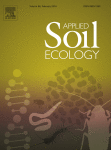Ver ítem
- xmlui.general.dspace_homeCentros e Institutos de InvestigaciónCIAP. Centro de Investigaciones AgropecuariasInstituto de Patología VegetalArtículos científicosxmlui.ArtifactBrowser.ItemViewer.trail
- Inicio
- Centros e Institutos de Investigación
- CIAP. Centro de Investigaciones Agropecuarias
- Instituto de Patología Vegetal
- Artículos científicos
- Ver ítem
Switching between monocot and dicot crops in rotation schemes of Argentinean productive fields results in an increment of arbuscular mycorrhizal fungi diversity
Resumen
Despite the importance of mycorrhizal symbiosis, we understand little how different soil managements affect arbuscular mycorrhizal fungi (AMF) communities. Crop rotation is recommended in sustainable agriculture because of its benefits in soil fertility improvement and positive effect decreasing soil borne diseases incidence and pest abundance. Amplicon sequencing of LSU and SSU rRNA gene fragments was used to analyse AMF diversity in fields from one of
[ver mas...]
Despite the importance of mycorrhizal symbiosis, we understand little how different soil managements affect arbuscular mycorrhizal fungi (AMF) communities. Crop rotation is recommended in sustainable agriculture because of its benefits in soil fertility improvement and positive effect decreasing soil borne diseases incidence and pest abundance. Amplicon sequencing of LSU and SSU rRNA gene fragments was used to analyse AMF diversity in fields from one of the most productive regions in Argentina, which varied in the main class of the plant component included in the crop rotation scheme. The samples encompassed different agricultural settings; one involving only monocot plants in the crop rotation schemes, one including a dicot crop, and the other an alternation and/or a combination of monocot and dicot plant components. We found lower richness and diversity in soils under monocot succession than in a dicot/monocot rotation or consociation. We observed that agricultural management had an influence on beta diversity patterns. Principal coordinate analysis showed that communities from the dicot/monocot rotation or consociation samples clustered together and separated from the monocots samples. These findings suggested that the increment of soil AMF diversity is more dependent on the alternation between monocot and dicot crops than other factors related to the farming systems.
[Cerrar]

Autor
Albarracín Orio, Andrea Georgina;
Brücher, Elsa;
Ducasse, Daniel Adrian;
Fuente
Applied soil ecology 98 : 121-131. (February 2016)
Fecha
2016-02
ISSN
0929-1393
Formato
pdf
Tipo de documento
artículo
Palabras Claves
Derechos de acceso
Restringido
 Excepto donde se diga explicitamente, este item se publica bajo la siguiente descripción: Creative Commons Attribution-NonCommercial-ShareAlike 2.5 Unported (CC BY-NC-SA 2.5)
Excepto donde se diga explicitamente, este item se publica bajo la siguiente descripción: Creative Commons Attribution-NonCommercial-ShareAlike 2.5 Unported (CC BY-NC-SA 2.5)

